For this RankSense webinar, we were very excited to be joined by Dale Bertrand, President of Fire&Spark, to talk about technologies and techniques to accelerate the SEO timeline. In his presentation, Dale explored the difference between the Traditional SEO timeline and Agile SEO timeline, and how to utilize Agile SEO with RankSense to further speed up the time it takes to see SEO results.
We’d like to say a big thank you to Dale for such a great presentation as well as all those who attended. We hope you enjoyed the webinar!
You can watch the full recording here:
https://vimeo.com/378816659
You can also revisit the slides that Dale presented here:
<iframe src="//www.slideshare.net/slideshow/embed_code/key/N37I5XCo9UL22Q" width="595" height="485" frameborder="0" marginwidth="0" marginheight="0" scrolling="no" style="border:1px solid #CCC; border-width:1px; margin-bottom:5px; max-width: 100%;" allowfullscreen> </iframe> <div style="margin-bottom:5px"> <strong> <a href="//www.slideshare.net/hamletbatista/agile-seo-faster-seo-results" title="Agile SEO: Faster SEO Results" target="_blank">Agile SEO: Faster SEO Results</a> </strong> from <strong><a href="https://www.slideshare.net/hamletbatista" target="_blank">Hamlet Batista</a></strong> </div>
Traditional SEO vs. Agile SEO
Dale went over the standard timeline of what they’ve done for SEO clients, referring to each stage as a “marathon”. The first “marathon” would start with an audit of their keyword strategy and technical SEO, which usually takes 3-4 weeks then they would provide clients with recommendations.
The next “marathon” would be the implementation stage where they make adjustments on their clients’ websites, work with the programmer to get SEO recommendations implemented, and work with marketers to write metadata such as title tags and descriptions. Depending on how much is broken that needs to be fixed, this second stage could take a little over a month.
The last “marathon” would be reviewing their results by looking at tools like Google Analytics, Search Console, or Shopify (for ecommerce sites). In this stage, they are looking to see if the rankings are there or if there is an increase in organic sales. This stage normally takes another month because they are also waiting for everything to get crawled and indexed by Google in order to measure the results.
Overall, this traditional SEO timeline takes at least 3 months before the client can see any benefit to what Dale and his team are doing.
In contrast, Dale presented the Agile SEO approach. In this approach, he refers to each stage as a “sprint”, further emphasizing its speed. Each “sprint” consists of all three of the marathons in the traditional SEO timeline, but modified to be done quicker.
They start with a lightweight audit where they look for a specific opportunity to go after quickly such as a broken disavow file or backlinks where other websites are linking to them but pointing to pages that don’t exist anymore that can be found in a matter of days. They would then recommend fixes to this specific opportunity and validate that the problem has been fixed so they can make it live to Google and view the result.
Although it still takes Google a few weeks to crawl and index the pages, the 3-month cycle shown in the traditional SEO timeline is condensed into 2-3 weeks depending on what type of issue is being fixed. This allows the client to see results faster and fits really nicely with an SEO experimentation methodology discussed later in the presentation.
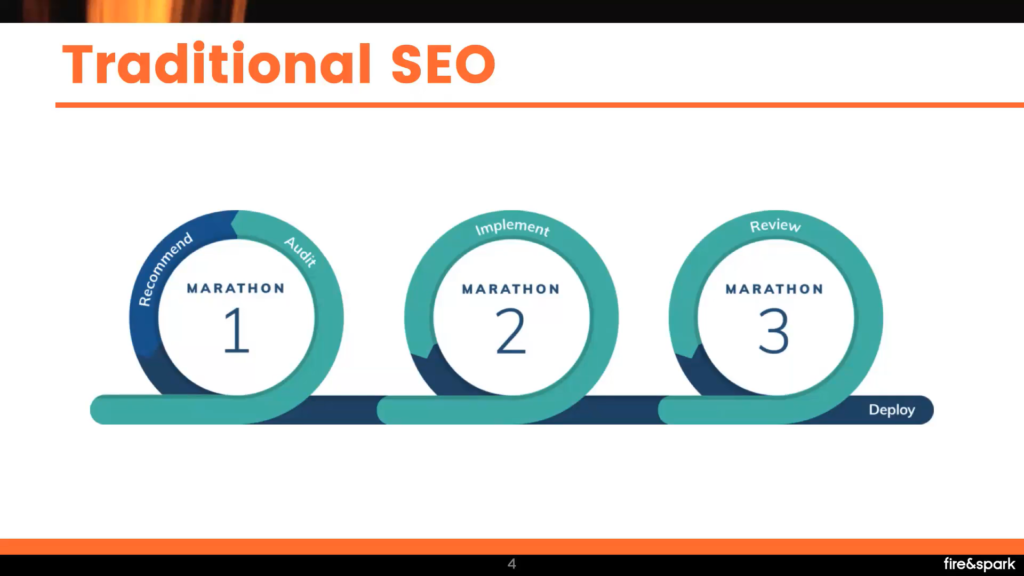
SEO Experimentation Case Study
In an SEO experimentation case study, Dale and his team worked with an online gift retailer. That client’s situation was that they had stagnant organic traffic, even as they were going into the holiday season.
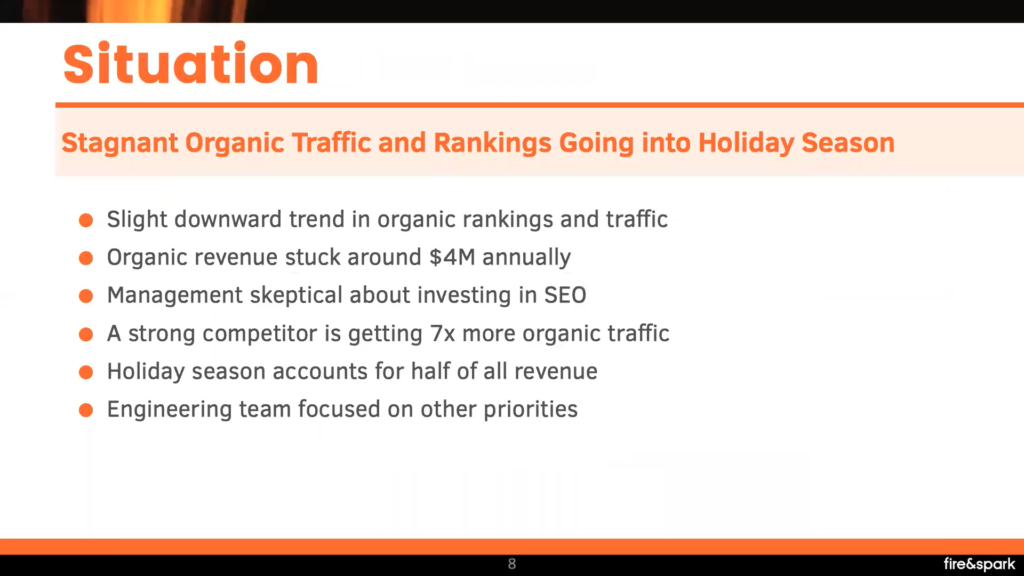
Dale and his team also took a look at the revenue opportunity from organic and how much money they thought they could create through an increase in sales to try and solve this problem for the client. They found a direct competitor that was doing 7x-15x more organic traffic than their client. Inputting this number together with the conversion rates and the average order value they were seeing on the site, they estimated an organic opportunity of $9M in incremental revenue if they could get the client’s traffic to the same level as the competitor.

Dale and his team also noticed that the competitor was ranking for more keywords than their client which fed into the strategy that they chose for this client.

They chose the following strategy for this client:
- Target more gift keywords
- Focus on authority and reputation with link building
- Optimize metadata to get better rankings by optimizing titles for the right keywords
- Get high click-through rates by optimizing their meta description
- Promotion by connecting with bloggers and online influencers

Dividing Work into Sprints
Sprint #1 – Adding structured data
Dale and his team took a few days to make sure their client was getting the star ratings, reviews, price, and availability in the snippets that are shown in their search results page.

Sprint #2 – Optimizing Product Page Meta Descriptions
Dale and his team added calls to action such as “shop”, “buy”, “discover”, or “find”. They wanted to include that language to make sure customers clicked on their result rather than the competitor’s result. They also added offers such as “free shipping”, “return anytime”, “Made in the USA”, “lifetime guarantee”, “recyclable”, and “batteries included” as well as a last reviewed date to show customers that the website had relevant reviews. They also added more product info and higher value keywords. This yielded a slight increase in click-through rates.

Sprint #3 – Optimizing Product Page Titles
Dale and his team spent a week tackling product page titles and writing product descriptions that included keywords. This was the sprint that yielded much higher results which allowed them to rank for more keywords and get better rankings for keywords that they were targeting with product data.

Sprint #4 – Creating Targeted Collection Pages
Dale and his team created collection pages for things like “Gifts for Teens”, “Gifts for Outdoorsmen”, or “Gifts for Hunters”. They were able to put together a list of thousands of gift keywords that they wanted to target with collection pages.
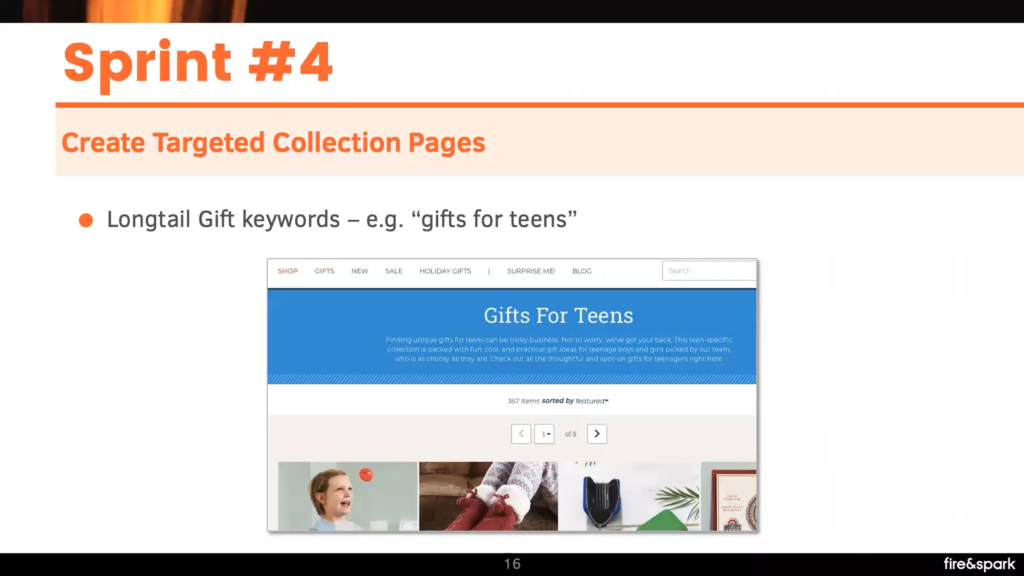
Tools Used
Dale and his team used the following tools during the SEO sprints to find the “quick win” opportunities:
- Search Console for keyword data and to understand what they rankings were as reported by Google
- Google Analytics to give them information on their organic landing pages and visitor behavior on the site
- Ahrefs primarily for competitor data and keyword expansion
- Deepcrawl to crawl websites and generate reports on what’s broken
- SEO Minon, a Chrome extension that allowed them to see metadata, canonicals, etc. on the site they were doing SEO for
- Excel for one-off analyses to understand things such as striking distance keywords or keywords that were at the bottom of the page which are considered “low-hanging fruit opportunities”
Deep Dive: Product Page Keyword Research (Sprint #3)
When Dale and his team were in the middle of Sprint #3, optimizing product page titles, they used their model for keyword expansion for product pages where they look at product details, descriptive words, synonyms for those words, and, diving deeper, they look at problems that the product or page solves.

Dale presented the example of a past client that sold the Ergo Sitting Stool, an “Adult active sitting stool” that yielded an average of only 50 monthly searches. They applied their model by:
- Looking at product details – they brainstormed keywords such as “orange”, “lightweight”, and “compact”
- Looking at descriptive words for product – they came up with keywords such as “comfortable”, “functional”, and “affordable”
- Looking at synonyms – they came up with keywords such a “stool”, “seat”, “seating”, and “chair”
- Looking at problems the product solves – they came up with keywords such as “neck pain”, “back pain”, “osteoporosis”, “bad posture”, and “body alignment”
- Looking at use cases – they came up with keywords such as “office chair”, “desk chair”, and computer chair”


Going back to the online gift retailer client, when Dale and his team discovered high-value keywords for that project, they optimized meta title, H1, and meta description. In regards to SEO experimentation, they wanted to do these optimizations on a subset of the product pages, especially for a large site, so that they can make sure they’re seeing results before putting in the effort to roll it out on the entire site.
They also included the keywords in on-page copy, internal links when linking to pages internally, and external links, or backlinks for third-party websites.
Case Study Results
Dale and his team saw some great results with this particular project. They were able to increase holiday sales per day compared to the previous year.
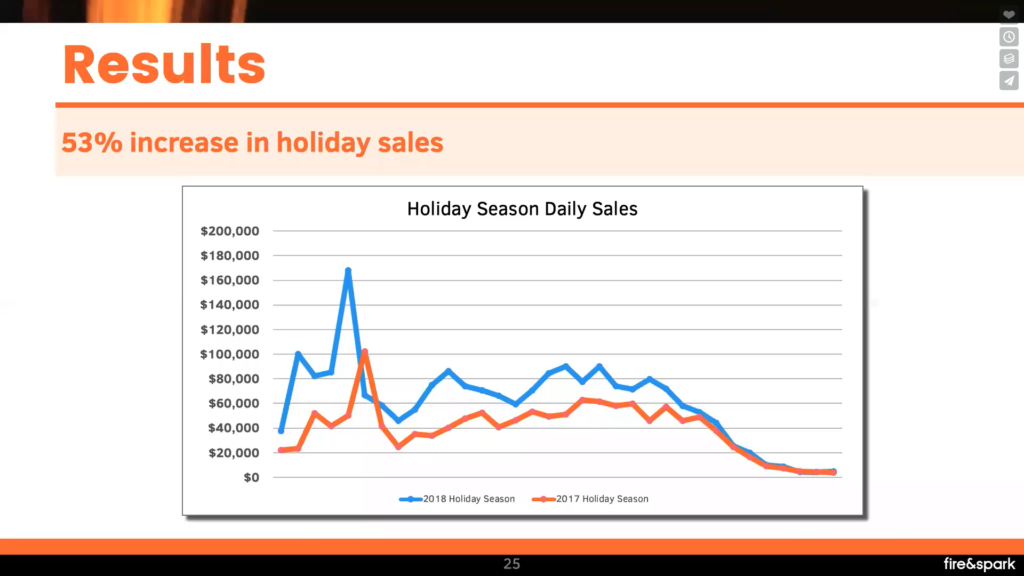
The Problem: Slow SEO
Dale and his team did not have Agile SEO at the time of this experimentation which resulted in a longer process. Although they implemented the experimentation methodology with sprints, it took longer than they would have liked because of the lack of a good software. If they could have reduced the time it took them to see results by half, they would have been able to see results before the holiday season which would have resulted in an even bigger boost in organic traffic and organic sales during the holiday season.
Fast Agile SEO with RankSense
RankSense – Make Changes
The first thing Dale and his team are using RankSense for is to make changes such as title tag changes. Instead of having to talk to a client’s Engineering team and get the changes approved, which normally adds at least 3 weeks to the timeline, they are able make changes through the RankSense tool which automatically applies the changes to the website without having to go through the Developer or Engineering team.
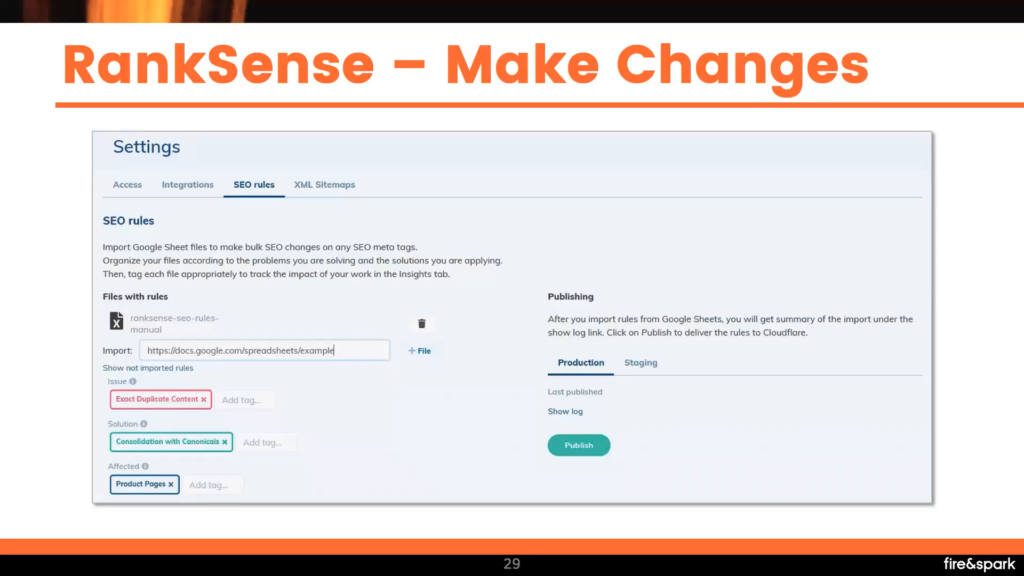
RankSense – Track Changes
From there, Dale and his team use the RankSense tool to track the changes. RankSense lets them know when Google has crawled those pages that he and his team are experimenting on as well as when Google has indexed those results.
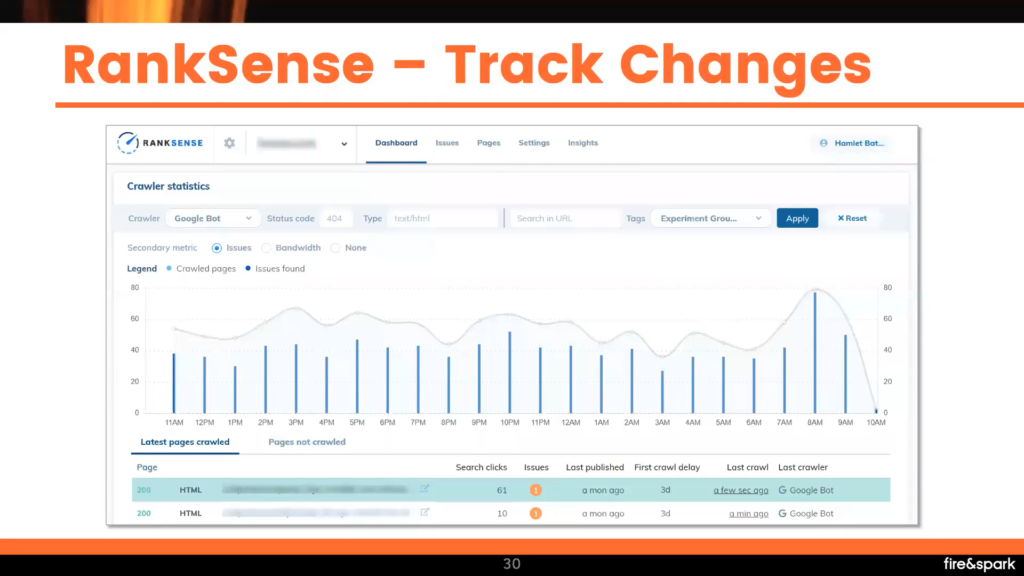
RankSense – Measure Impact
Dale can then measure the impact through the RankSense tool and determine if he sees the impact he wanted from the hundred or so test URLs that he made title tag changes to. If he sees the results that he wanted, he can either continue to do more experiments or use RankSense to apply the changes to the entire website. If not, he can try something else like move on to his fourth spread where they’re doing the same thing by using the RankSense tool with meta descriptions to increase click-through rate.
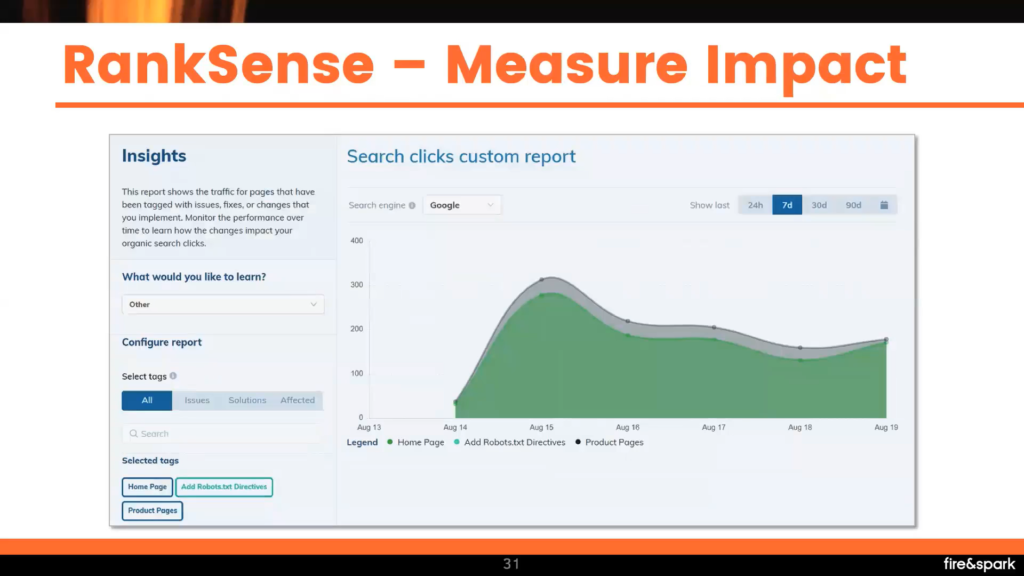
Timeline: 6 months to 6 weeks
In Dale’s many years of doing SEO and working as an SEO consultant, he often has to make many recommendations for one client because he doesn’t know which one will be the home run recommendation. However, with modern technology such as RankSense, he is able to try several things simultaneously without having to involve a client’s Engineering team at all which results in a shorter timeline.
Get Started with Agile SEO
To learn more about any of the SEO methods discussed in this webinar, you can book a 30-minute Agile SEO Strategy Session with Dale Bertrand here or you can email Dale at [email protected]. To learn more about RankSense and to try our software, contact us today.
















